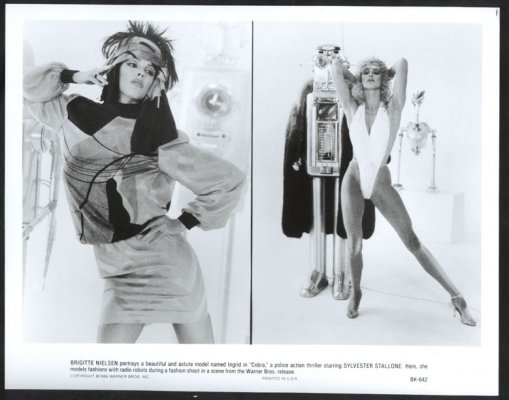B-MOVIE BULLSH*T - Part Seventeen "A Cure That Kills"
 Monday, January 23, 2012 at 6:00AM
Monday, January 23, 2012 at 6:00AM B-Movie Bullsh*t
Part Seventeen
Cobra
(1986)
Lieutenant Marion “Cobra” Cobretti is a member of Los Angeles’ “Zombie Squad”—the term used for cops who take the cases that require them to sink to the lowest depths of human society. His latest case finds him searching for the “Night Slasher”, a vicious serial killer whose ubiquity and lack of any discernable pattern suggests he might not be working alone. Cobretti and his partner catch their first break when the Slasher and his cultists fail to kill the witness to a previous murder—a tall Nordic model named Ingrid Knudson. When it becomes clear that the Slasher has an inside man on the force, Cobra takes Ingrid out of L.A. to protect her, unaware that Nancy Stalk, a cop assigned to join them, is the mole. The Slasher and his goons descend upon the small town where they are hiding and Cobretti is forced to protect Ingrid and rid the world of the Slasher’s irredeemable evil.
As a film buff I can think of few careers I find more fascinating than that of Sylvester Stallone’s. After making a good impression in a series of low budget movies like The Lords of Flatbush, Capone, and Death Race 2000 (which features my favourite performance of his career), he rocketed to super-stardom as the writer/star of Rocky, which was not only a major box office hit, but also made him only the third person in Oscar history to be nominated for both writing and acting in the same year (Charlie Chaplin and Orson Welles were the two who preceeded him). He didn’t win, but at the time he seemed destined to join the pantheon of great American actors, with comparisons to Marlon Brando, Al Pacino and Robert DeNiro not being uncommon.
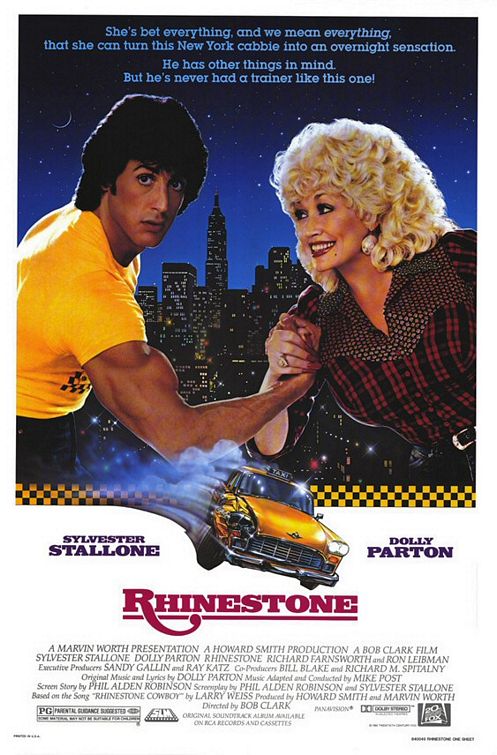 But then he followed up Rocky with two big flops—the union drama, F.I.S.T., and the period wrestling film, Paradise Alley, which he also wrote and directed. Fortunately, Rocky II resurrected him as a moneymaking force—enough so that the relative disappointment of the WWII soccer drama Victory had little effect on his clout, especially when Rocky III was on its way. His luck continued with First Blood, a film that gave him another iconic character in the form of emotionally damaged Vietnam vet, John Rambo, but then disaster struck in the double whammy of Staying Alive and Rhinestone.
But then he followed up Rocky with two big flops—the union drama, F.I.S.T., and the period wrestling film, Paradise Alley, which he also wrote and directed. Fortunately, Rocky II resurrected him as a moneymaking force—enough so that the relative disappointment of the WWII soccer drama Victory had little effect on his clout, especially when Rocky III was on its way. His luck continued with First Blood, a film that gave him another iconic character in the form of emotionally damaged Vietnam vet, John Rambo, but then disaster struck in the double whammy of Staying Alive and Rhinestone.
This is the period where Stallone’s hubris suddenly became apparent and his choices grew much more questionable. Staying Alive saw him staying behind the camera as writer/director (save for a two-second cameo) in an ill-advised sequel to Saturday Night Fever. The film confirmed what many suspected after seeing his previous directorial efforts—the success of Rocky was a group effort that included the participation of director John Avidson. Working solo and with full creative control Stallone suffered from severe creative limitations, including unimaginative storytelling and a complete lack of subtext.
Rhinestone saw him attempting to stretch his legs with a light musical comedy in which he played a taxi driver who’s transformed into a country singer after Dolly Parton makes a bet with her manager. A gender reversed My Fair Lady with cowboy hats and tassels, it was the first film that clearly showed the limits of his acting abilities.
Left bloodied by the back-to-back mega-flops, Stallone performed what would become his trademark move and returned to his two most popular characters in the same year. The results, Rambo: First Blood Part II and Rocky IV, were so overtly designed to appeal to the mid-80s audience that they turned once-credible characters into living cartoons. The slide in this direction had already started with Rocky III, which featured Hulk Hogan and the hilariously menacing Clubber Lang as its villain, but that film was a virtual cinema verite documentary compared to the cold war absurdity of Rocky IV.
 With that film Stallone attempted to transform his inarticulate, working-class-schlub-made-good into an out-and-out action hero. Rocky Balboa no longer fought to prove himself or to take care of his family, he fought to honor his former rival turned friend, Apollo Creed, who was murdered by nothing less than the terror of communism itself. In terms of absurd anti-Soviet propaganda, the film was in the same class as Red Dawn and Invasion U.S.A. Rocky ceased to be a recognizable human and became an unstoppable god bent on protecting capitalism at all costs.
With that film Stallone attempted to transform his inarticulate, working-class-schlub-made-good into an out-and-out action hero. Rocky Balboa no longer fought to prove himself or to take care of his family, he fought to honor his former rival turned friend, Apollo Creed, who was murdered by nothing less than the terror of communism itself. In terms of absurd anti-Soviet propaganda, the film was in the same class as Red Dawn and Invasion U.S.A. Rocky ceased to be a recognizable human and became an unstoppable god bent on protecting capitalism at all costs.
At this point I’d get all pretentious about what Rambo: First Blood Part II was about, but I’ve never actually seen the whole thing from beginning to end, but the snippets I have seen more than back up this analysis.
Unfortunately for Stallone both sequels were massive hits. Having been responsible for the two least-subtle films ever made, he came to the conclusion that this was what people wanted and he partnered up with a small studio for three films that paid him a lot of money, but also managed to wreck his career in a way from which he has never truly recovered, despite some notable successes here and there.
The studio was Cannon, founded and operated by two Israeli cousins named Menahem Golan and Yoram Globus. After breaking out with the Israeli period T & A teen flick Lemon Popsicle (a film that you’d assume was a Porky’s rip off if you didn’t know it was actually released in 1978), they gradually took over A.I.P’s spot as the pre-eminent producer of low budget genre movies, most of which had already made their money back before a single frame of film had been shot, thanks to foreign pre-sales.
But for Golan, money wasn’t enough. He wanted prestige and respect as well and decided to try to buy it by hiring Hollywood’s biggest star to become synonymous with Cannon. The failure of the second and third of the three films they would make together would eventually result in the bankruptcy of his once successful company.
Before this, though, Stallone made his Cannon debut with a cop picture he wrote that marked a clear attempt to add a third iconic character to his repertoire. Using a novel originally published by Paula Gosling in 1974 as the basis for his plot, he reimagined its male protagonist as a gun-worshipping cop whose distaste for lawbreakers made Dirty Harry look like Alan Alda in comparison.
In the novel, which was first published as A Running Duck and then retitled four years later as Fair Game, the cop hero was Mike Malchek, which didn’t come close to matching the badass cool Stallone was intent on giving the character. Instead he gave the character the last name of Cobretti, which supplied him with both a dangerous sounding nickname and the title for the film, Cobra. Interestingly, he then gave the character a feminine sounding name in Marion, which added a touch of much-needed humour to the film and served as a specific reference to the man who famously turned down the role of Dirty Harry Callahan—John Wayne (whose given name was Marion Morrison).
From the novel he took the elements of a cop protecting a woman who witnessed a violent crime and the mole who constantly leads the criminals to them, but from there he let his own imagination run wild. In the place of Gosling’s hitman, he came up with a hulking, monstrous serial killer who commands a cult of similarly insane maniacs (some of whom appear to be everyday businessmen in suits), and he turned her attorney heroine into a glamorous foreign model, which allowed for a fabulous posing/investigation montage (easily the film’s best scene) and the casting of his wife, 6’0” Danish goddess Brigitte Nielsen.
(In fact Stallone changed the plot of Gosling’s novel so much that virtually no one noticed when the same book served as the basis of the Joel Silver-produced Cindy Crawford starsploitation flop, Fair Game, just 9 years later.)
Possibly exhausted after taking on the directing chores of Rocky IV, Stallone handed over the reigns to Cobra to his Rambo: First Blood Part II director, George P. Cosmatos—a Greek born Canadian who would later direct the cult western Tombstone and who was previously responsible for the man-vs-rat Canuxploitation classic, Of Unknown Origin. In the end, all of Cobra’s virtues—eye-pleasing style, interesting mise-en-scene, exciting action—can be credited to Cosmatos’ influence and direction. Unfortunately he was working with a script and a star with two absurd agendas.
There’s a great moment in the documentary The Hamster Effect, where Terry Gilliam is talking to Bruce Willis on the set of Twelve Monkeys about a scene where his character is supposed to be knocked out by co-star Madeleine Stowe. Gilliam tells Willis how he wants to film it, but Willis argues with him, insisting that a woman Stowe’s size could never knock out a man the way Gilliam is suggesting. The argument is long and passionate and it quickly becomes clear that Willis’ reluctance has less to do with the integrity of the film than his desire to not be seen as a pussy.
It’s an insight into the behind the scenes process that explains many a terrible film (fortunately for Gilliam, he finally got what he wanted and Willis benefited by giving a great performance in one of his best movies). Many movie stars, especially in the action genre, want to be perceived as the most cool, awesome people alive and they do this without any irony. Therefore they force changes upon any script featuring moments that might humanize or lessen the awesomeness of their characters. Go back to my first B-Movie Bull-Sh*t review and you’ll find a film where Chuck Norris kills dozens of commies without so much as a scratch to show for it.
Now imagine what happens when a star who is very much of this persuasion actually writes the script himself! That’s Cobra, a film so dedicated to promoting the awesomeness of its title character (and the actor playing him) that the film instantly devolves into unintended self-parody.
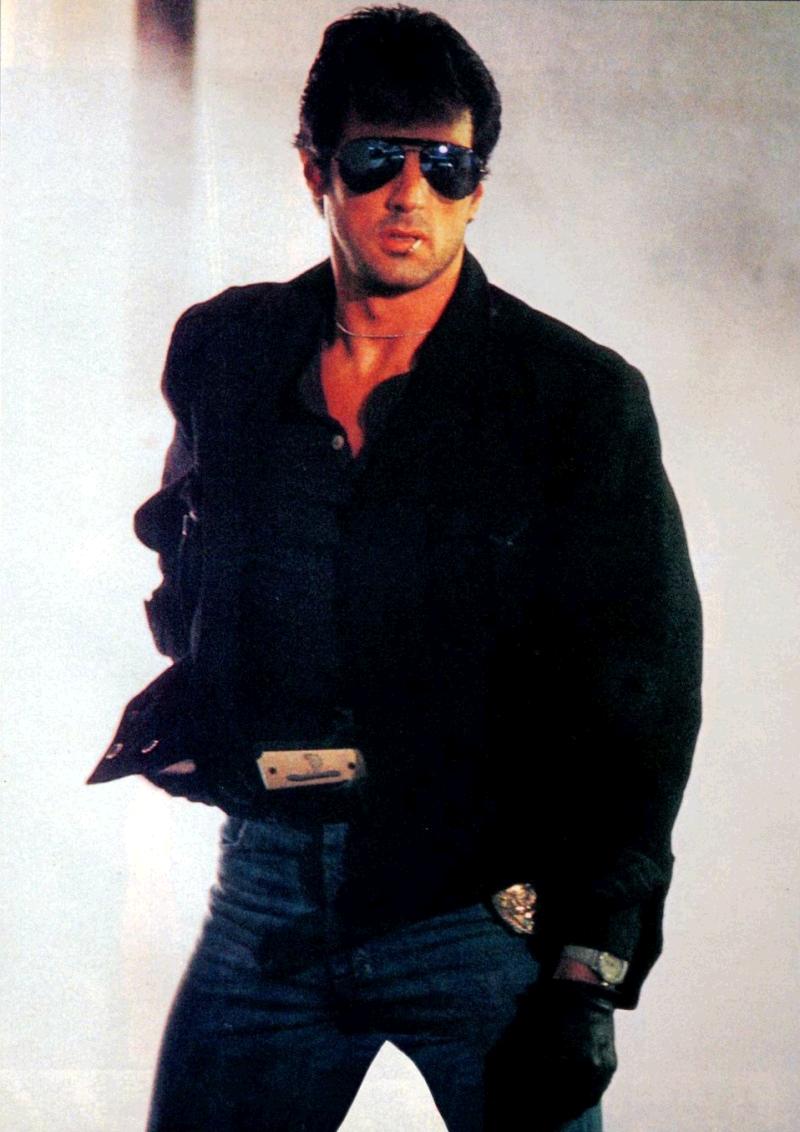
I mentioned Dirty Harry before and the comparison is extremely apt (although the film’s plot more closely resembles another Eastwood picture—The Gauntlet). Like Callahan, Cobretti is a gun fetishist (his weapon has a cobra pictured on its handle and we watch him clean it with loving care the first time we see him in his apartment) whose tough stance against criminals is harshly criticized by his liberal, namby-pamby superiors (one of whom, in the film’s biggest Dirty Harry homage, is played by Andrew Robinson aka The Scorpio Killer, Callahan’s original nemesis). But if Don Siegel’s film wore its conservatism on its sleeve, than Cobra dons it like a three piece suit, culminating in the truly hilarious moment where the Night Slasher taunts Cobretti by telling him how as a lawman he’s obligated to take him in and be tried by the courts, which will find him not guilty by reason of insanity.
Cobretti’s response to this is to
impale him on a large metal crane hook.
And whereas Callahan chose to throw his badge into the water after gunning down Scorpio vigilante-style, Cobretti is congratulated for his actions and gives the audience a thrill when he punches Robinson’s character in the face for being such a left-wing fag.
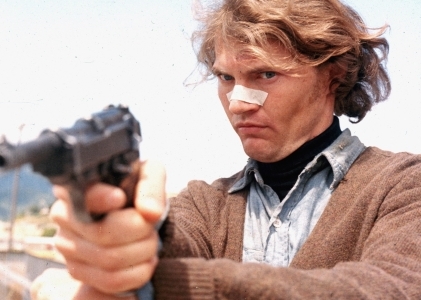 The two films also depart significant in the depiction of their two villains. In Dirty Harry, Scorpio is a pathetic hippy whose big plan to stop his adversary is to hire a black man to beat him up and pin his bruises and injuries on Callahan—getting him thrown off the case and earning the sympathy of liberals concerned more about so-called “police brutality” than keeping the public safe. In Cobra, the Night Slasher is played by Brian Thompson, a 6’3” monster of a man whose craggy face invokes a strange kind of handsomely charismatic monstrosity. Rather than acting alone, his character is shown to be a leader of a cult dedicated to the creation of a “new world” where the hunters rule over the hunted, but we’re never shown any reason why he would have such a following or why they would be so dedicated to him. We’re simply supposed to take their existence at face value.
The two films also depart significant in the depiction of their two villains. In Dirty Harry, Scorpio is a pathetic hippy whose big plan to stop his adversary is to hire a black man to beat him up and pin his bruises and injuries on Callahan—getting him thrown off the case and earning the sympathy of liberals concerned more about so-called “police brutality” than keeping the public safe. In Cobra, the Night Slasher is played by Brian Thompson, a 6’3” monster of a man whose craggy face invokes a strange kind of handsomely charismatic monstrosity. Rather than acting alone, his character is shown to be a leader of a cult dedicated to the creation of a “new world” where the hunters rule over the hunted, but we’re never shown any reason why he would have such a following or why they would be so dedicated to him. We’re simply supposed to take their existence at face value.
And just like Cobretti’s gun, the film fetishizes the Slasher’s primary instrument of terror, a large menacing knife with sharp spikes along its bearer’s knuckles. The absurd bigness of the villain is clearly meant to prove the badass amazingness of Stallone’s character. Any wimp with .45 Magnum can kill a hippy—it takes a real man to take down a monster straight from Hell.

As frequently (and unintentionally) funny as this all is, there’s a clear sense of desperation that saturates the entire film. It would have seemed impossible after Rocky IV that Stallone could pander any lower to the public’s desire to see the clearly good battle the obviously evil, but with Cobra he managed to do just that and deliver a movie so pathetically geared to get morons to shout out “FUCK YEAH!” he might as well have ended it with a group chant of “U.S.A.! U.S.A.! U.S.A.! U.S.A.! U.S.A.!”
That said, for all his lack of subtlety and willingness to pander to the public’s most basic impulses, his scripts almost always feature an interesting character detail or two that suggests the highly intelligent, articulate man he frequently comes across as in interviews and making-of documentaries. In Cobra I enjoyed a moment between Cobretti and Knudson at a local truck stop diner where we see her purposefully dump half a bottle of ketchup on her French fries. It's completely extraneous but reminded me of Paulie’s paintings in Rocky Balboa—another touch that suggested the work of a much better filmmaker.
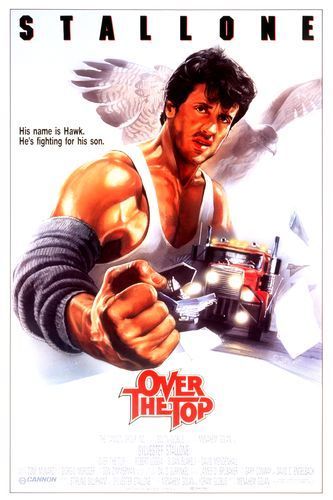 Cobra ended up doing relatively well at the box office (but not enough to warrant a sequel, even though the creation of a new franchise was its clear intention), but his next film for Cannon—for which he earned the then-shocking payday of $12,000,000—was Over the Top, an arm-wrestling melodrama directed by Golan. It flopped so spectacularly that Cannon bought the rights to Stallone’s second biggest franchise in a clear bid to recoup their costs with a sure thing. The resulting Rambo III was—at $60,000,000—one of the most expensive movies made up to that time and proved to be another costly flop. The one-two punch of these costly failures resulted in Cannon’s bankruptcy.
Cobra ended up doing relatively well at the box office (but not enough to warrant a sequel, even though the creation of a new franchise was its clear intention), but his next film for Cannon—for which he earned the then-shocking payday of $12,000,000—was Over the Top, an arm-wrestling melodrama directed by Golan. It flopped so spectacularly that Cannon bought the rights to Stallone’s second biggest franchise in a clear bid to recoup their costs with a sure thing. The resulting Rambo III was—at $60,000,000—one of the most expensive movies made up to that time and proved to be another costly flop. The one-two punch of these costly failures resulted in Cannon’s bankruptcy.
Since then Stallone has famously spent his career starring in major flops (Stop or My Mom Will Shoot!, Oscar, Judge Dread, Assassins, An Alan Smithee Movie: Burn Hollywood Burn, Get Carter, Driven, D-Tox, Avenging Angelo) and the occasional modest hit (Cliffhanger, Demolition Man, The Specialist). After killing his top franchise with the humdrum and disappointing Rocky V, he waited 16 years before doing the one thing that kept his career going in the 80s—returning to the two characters people loved the most. The results, Rocky Balboa and Rambo, managed to earn money and even some good reviews largely on the basis of nostalgia alone. Sensing this, Stallone decided to capitalize on Gen X’s fondness for the no-nonsense action pictures of old and created The Expendables, which marked his first successful attempt at a franchise in over two decades.
For all of its many faults, I found Cobra fascinating for its part in such a tumultuous Hollywood career. Made for all of the worst reasons possible, it’s a textbook example of what happens when a superstar aims for the lowest common denominator and still manages to miss.
